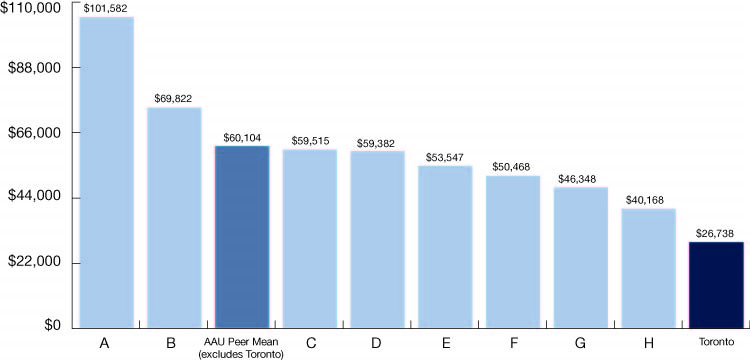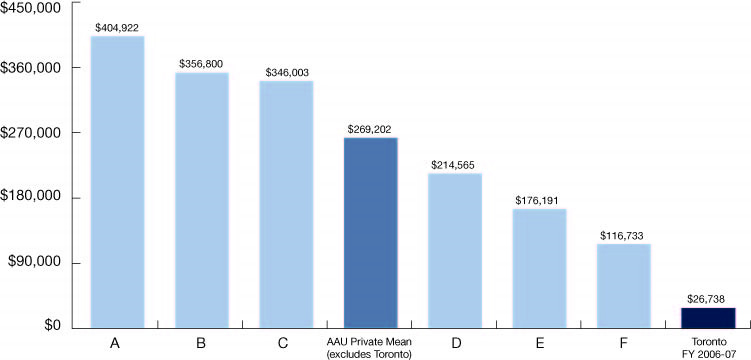To members of the University of Toronto Community: I am taking this opportunity to provide a brief update on two fronts – the current fiscal climate, and the extraordinary collective achievements by members of the University of Toronto over the last few years. The juxtaposition of these topics is deliberate: the university clearly faces some economic headwinds in the year ahead, but we do so with substantial academic momentum.
Challenges in 2009
The economic forecast remains guarded. As has already been reported, recent turmoil in the financial markets – the likes of which we have not see since the 1930s – will severely limit the university’s ability to draw on endowment revenue. The endowment was slated to pay out $62 million in April of this year. Part of our endowment strategy involves building up a funding cushion so that payouts can still be made when there is a moderate downturn in the markets. The massive decline in the equity markets, however, has eliminated that cushion. We must therefore prepare for a situation where the scheduled endowment payout is either markedly reduced or foregone for the year.
I want to address the rationale for not eroding accumulated capital to make these payouts regardless of income earned. These endowments were put in place for the very long haul. Erosion of capital would immediately change the baseline for future growth in our endowed funds. It would thereby compromise our ability to return rapidly to usual payout levels as the investments supporting our endowments recover their value. Prudence in managing the endowment is accordingly part of the responsible stewardship of funds that were designed to support the university’s faculty, staff and students for generations to come. Meanwhile, the divisions of the university are all planning actively to ensure that, if usual endowment payouts cannot be made, they will still be able to meet critical commitments such as endowed professorships and chairs, as well as endowed support for needs-based student aid.
On that point, I must thank our benefactors for their response. Naturally, donors share our concerns about the possibility of reduced payouts on endowed funds. However, many have expressed support for the university’s strategy, including appreciation for our contingency planning to cover key commitments using internal funds if necessary. We have also had donors come forward with new annual gifts to help bridgefund personnel and projects supported by their endowed benefactions, or to support areas of urgent needs, such as entrance scholarships and bursaries for our students. To say the least, their generosity and loyalty has been both inspiring and very encouraging.
While a suspension of this year’s payouts seems both prudent and probable, I should emphasize that our budget plans for 2009-10 presuppose the resumption of endowment payouts. The level will be determined based on market conditions as the year progresses. The status of the endowment is our most acute financial concern – one that should be self-limited as the world economy stabilizes and investment performance improves. However, as noted previously, the level of government per-student grants in support of our core operations is also uncertain. Caps on government transfers to universities may exacerbate our budget pressures by several million dollars. Should this come to pass, the impact will vary across divisions. Divisions also vary in their reliance on payouts from endowed funds, and in the amount that they contribute to the university’s overall fiscal balance. In these circumstances, any across-the-board budget reductions may have perverse or unfair effects. Similarly, our hope is to avoid a general hiring freeze for 2009 10. Instead, each division of the university, including the central administrative divisions, will be expected to contain costs using measures most appropriate to its specific circumstances.
I should add that the provost continues to review each university division’s budget plans with division heads to assess the division’s prospects of achieving budgetary balance. In this regard, while savings must be realized in operating costs wherever feasible and reasonable, and while all divisions are expected to use “rainy day funds” to the fullest extent possible to navigate this stormy period, we must also be measured in our responses to what is likely to be a medium-term budget crisis. We are certainly not encouraging deficit finance by divisions but that may be a necessary short-term measure in some cases. As a result, it seems unlikely that we can bring the university’s budget to the balance planned for this year in accordance with our fiscal cycle. This is a matter that I and other members of the executive group will be continuing to discuss with governors of the university.
It is worth remembering that though these are difficult times everywhere, the University of Toronto is faring as well or better than many of its peer institutions across Canada and, indeed, throughout North America. As well, the higher-education sector in general has so far been spared some of the massive restructuring confronting other sectors of the economy.
A university president has no special expertise in economic prognostication and I cannot predict the duration of this downturn. Some pundits expect the current fiscal crisis to continue for at least 18 months, but then again, few of these same pundits foresaw the current trouble! Thus, we must simply wait and see how fast the economy recovers. While the timing of a recovery is uncertain, two things are clear. First, there will indeed be a recovery. And second, thanks to the excellence of our faculty, staff, students, alumni and friends, we shall weather this storm successfully.
A Legacy of Accessible Excellence
This past year, the provincial government made a very welcome commitment to a large scale capital investment in Ontario’s colleges and universities. The government of Ontario has aimed not only to address long-standing challenges of deferred maintenance on campuses, but also to foster exciting initiatives in teaching and research. A province- wide review process has just been completed. As part of that review, consultants working on behalf of the provincial government visited our three campuses in December to hear our story and to consider the merits of our capital proposals. Preparing the university’s presentation afforded me a rare opportunity to compile and share with our visitors just a few of the indicators of the University of Toronto’s success in recent years. That success, of course, is due to the talents and efforts of all members of our community, and the indicators are very encouraging indeed.
- Publications and Citations
We continue to attract excellent students because we continue to recruit and retain excellent faculty and staff. One measure of the excellence of our community is its collective scholarly output. Across a staggering range of disciplines, the University of Toronto is one of the leading research universities in North America.
Figure 1 highlights publication and citation data from diverse areas of science and technology. Journal-based publication data are less helpful for social sciences, but show the University of Toronto ranking with the top 10 U.S. public universities across disciplines as varied as geography, psychology, ethics, women’s studies and industrial relations. Rolling all disciplines together, only Harvard publishes a greater number of scholarly papers. Humanities performance indicators paint a similarly compelling picture. Put simply, from the standpoint of overall excellence in scholarship, no post-secondary institution in Canada is close to the University of Toronto.
- Rankings
Omnibus rankings of universities continue to be generated by various media outlets and agencies, just as questions continue to be raised about the basis of the various metrics and combinations thereof that are compiled and published.
The issue, of course, is not the need for rigorous assessment and disclosure of discrete dimensions of performance, but rather the tossed salads of measures served up annually to those seeking – with apologies to Mencken – simple answers to complex questions.

Among those specific measures of performance that we have long taken seriously is assessment by academic peers. While peer-review surveys have their own limitations, such surveys can shed some useful light on how a university’s scholars are perceived by others in the same field. The Times Higher Education Supplement (THES), for example, ranks U of T 41st in the world according to its “tossed salad” of criteria. But when the THES asked the scholars at different universities to rank each other, our peers placed us ninth in the world – and top among Canadian universities. In fact, the University of Toronto is one of only five universities to place in the top 16 in every field peer-reviewed for the THES. The other four were Berkeley, Oxford, Cambridge and Stanford. Figure 2 shows some of the most recent rankings of research-intensive universities.
- Awards and Honours
Our students and faculty represent U of T with distinction. Figure 3 shows that our faculty, in particular, win far more awards and prizes than would be expected given the size of our professoriate. It is also striking to see U of T’s faculty celebrated at a higher rate both internationally and for the most prestigious Canadian prizes – those competitions in which the bar is set highest and meritocratic peer review prevails.
- Access and Student Aid
One of the distinguishing features of the University of Toronto is the extent to which it has sustained access to outstanding educational opportunities – inside and outside the classroom – for the best and the brightest students regardless of means. Our campuses are among the most ethnoculturally diverse in the world and over 40 per cent of our undergraduate students report a combined family income of less than $50,000 a year. In fact, U of T contributes more than twice the provincial average to student bursaries and financial aid.
The Governing Council has also committed the university to the following policy: No student offered admission to a program at the University of Toronto should be unable to enter or complete the program due to lack of financial means. This commitment is particularly important for the next year or two, as the recession will compromise the finances of some of our students and their families.

As Figure 4 shows, we have an enviable record of success in sustaining access to excellence. The Government of Ontario deserves huge credit for enhancing OSAP eligibility under its 2005 “Reaching Higher” plan for higher education. However, the university’s ongoing success in maintaining access would simply not have been possible without increased revenues from tuition, because we continue to draw heavily on tuition revenues for needs-based bursaries. The Faculty of Law at U of T offers compelling lessons in this regard. Currently, about half our students taking their first law degree apply for internal student aid. The faculty is able to help in a major way thanks to tuition revenues. In fact, 16 per cent of all students in the Juris Doctor program receive bursaries that offset at least 50 per cent of their tuition fees, and 33 students are paying no tuition fees this year.

Funding: An Acute and Chronic Challenge
Our current financial circumstances are frustrating in part because they represent an intensification of longstanding challenges. Figure 5 compares the university’s per student funding to our public peers among research-intensive universities in the United States.
U of T receives less than half the mean per-student funding available to our peers. Figure 6 is more striking. It shows the dramatically higher per-student funding available to the private universities in the U.S. I should emphasize, in fairness, that the levels of per student funding for U.S. private universities include endowment returns generated before the crash of 2008, and that the per-student resources available do not necessarily reflect those typically spent in a given year. Although the differences in funding are large, the scholarly footprint of U of T is strongly competitive in width and depth with all these great private universities.
Drawing comparisons closer to home, notwithstanding the McGuinty government’s praiseworthy “Reaching Higher” plan, the educational grants per student available for Ontario’s universities remain more than 25 per cent below the average funding available to university students in the other nine provinces. The missing money, unfortunately, is tied to longstanding imbalances in fiscal federalism. This fall, Don Drummond, chief economist of the TD Bank, has estimated that Ontario unfairly gave up $11.85 billion in 2005. In essence, Ontario’s taxpayers and students are underwriting higher education in other provinces. The federal government has fortunately agreed to a number of positive changes in shared-cost social programs, but implementation of these reforms to fiscal federalism is slated to take several years.
Figure 7 shows that, until recently, Ontario’s real per-student funding of higher education had been falling over many years. In contrast, Ontario’s per-capita spending on healthcare and per-student spending on K-12 education has tracked much closer to national benchmarks. We must encourage the Ontario government to maintain and augment its investments in higher education, research and innovation. And we must continue to encourage the federal government to accelerate its rebalancing of fiscal federalism while enhancing its support for research, innovation, student aid and university infrastructure. The ultimate beneficiaries will be future generations of students through enhanced access to a positive, personalized and well-rounded university experience.
(In January, as U of T Magazine was going to press, the federal budget provided a welcome infusion of funding for university infrastructure along with an acceleration of the redress for Ontario within the framework of fiscal federalism. While measures in the budget also sparked concern about the federal granting councils, there remain grounds for optimism that Ottawa will augment operating support for research in 2010-11.)
Great Stories – and a Great Future
Given the serious funding gap that has continued for two decades, it is truly remarkable that the University of Toronto has emerged as one of the world’s great public universities. Ours is not so much a uniquely Canadian success story as a cumulating collection of success stories. By many measures, the institution’s academic fabric has never been stronger. While 2009 will bring ongoing financial turbulence and some difficult decisions, I am confident that, in the longer run, U of T will continue to excel. That confidence, in turn, reflects an extraordinary record of success attributable to the talent, commitment and creativity of our faculty, staff, students, alumni and friends. In the circumstances, I consider it a continuing privilege to be part of our university community. Thank you for your varied contributions to the University of Toronto.
Best wishes,
David Naylor










